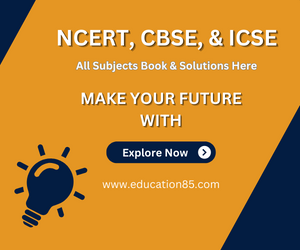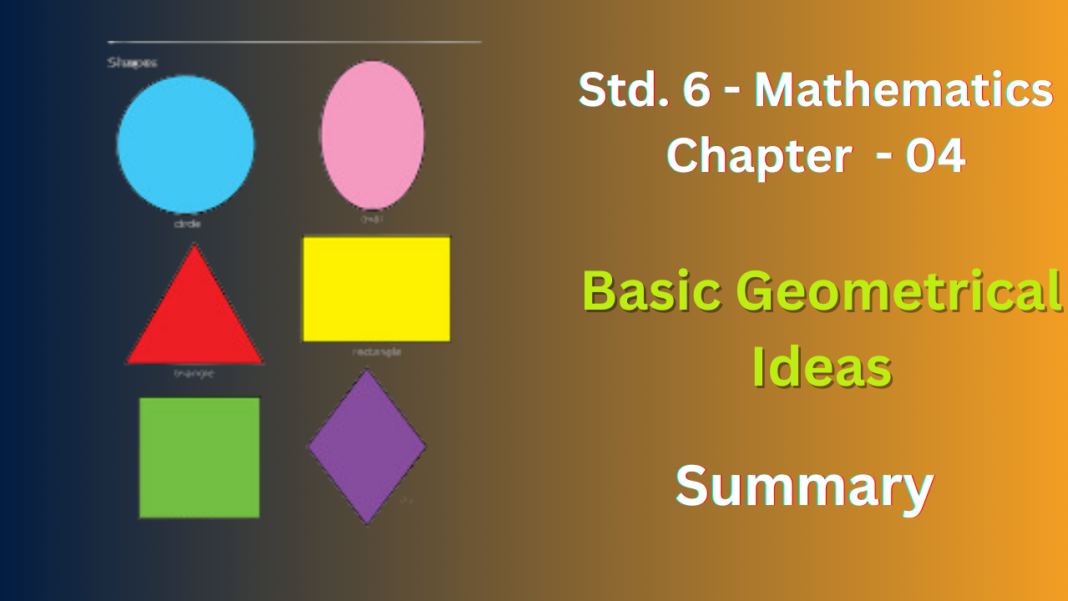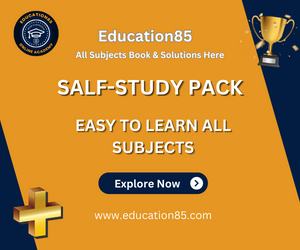NCERT Solutions for Class 6 Maths Chapter 4
The chapter Basic Geometrical Ideas introduces fundamental concepts in geometry, laying the foundation for future mathematical understanding of shapes and spatial relationships. Here’s a breakdown of key areas covered:
Points, Lines, and Rays:
- Points: Represented by a small dot, they have no dimension (length, width, or height).
- Lines: A straight path that extends infinitely in both directions. It has only length, marked by two distinct points (endpoints).
- Rays: A straight path that originates from a single point (endpoint) and extends infinitely in one direction.
Line Segments:
- A line segment is a part of a line with two distinct endpoints. It has a definite length.
Intersecting and Parallel Lines:
- Intersecting lines: Two lines that meet at a single point.
- Parallel lines: Two lines that never meet, no matter how far they are extended.
Angles:
- An angle is formed by two rays with a common endpoint (vertex). The space between the rays is called the interior of the angle.
Types of Polygons:
- Polygons: Closed shapes formed by straight line segments connected at their endpoints.
- Different types of polygons are classified based on the number of sides:
- Triangle (3 sides)
- Quadrilateral (4 sides) – further classified into squares, rectangles, parallelograms, and trapezoids (based on angle properties and side lengths)
- Pentagon (5 sides), Hexagon (6 sides), and so on (higher-sided polygons)
Circles:
- A circle is a closed, curved shape with all points at a constant distance (radius) from a central point (center).
Key points to remember:
- Geometric shapes can be classified and named based on their properties.
- Points, lines, and rays are fundamental building blocks for creating shapes.
- Understanding angles and their measurement is crucial in geometry.
This summary provides a basic overview of the chapter. For a deeper understanding, it’s recommended to refer to your textbook or practice exercises related to these concepts.
NCERT Solutions for Class 6 Maths Chapter 4 Basic Geometrical Ideas
Exercise 5.1
1. Use the figure to name:
(a) Five points
(b) A line
(c) Four rays
(d) Five line segments
Ans :
(a) Five points:
A
B
C
D
(b) A line:
DB Or BD
(c) Four rays:
OA (originating at O and going towards A)
OB (originating at O and going towards B)
OC(originating at O and going towards C)
OD (originating at O and going towards D)
(d) Five line segments:
AB
BC
CD
DE
OA
2. Name the line given in all possible (twelve) ways, choosing only two letters at a times from the four given.
Ans :
Twelve possible names:
- AB
- BA
- BC
- CB
- CD
- DC
- AD
- DA
- AC
- CA
- BD
- DB
3. Use the figure to name:
(a) Line containing point E.
(b) Line passing through A.
(c) Line on which 0 lies.
(d) Two pairs of intersecting lines.
Ans : (a) Line containing point E:
- Line DE
(b) Line passing through A:
- Line AB (or Line BA depending on reading direction)
(c) Line on which 0 lies:
- CO
(d) Two pairs of intersecting lines:
- CO or AE
4. How many lines can pass through
(a) one given point?
(b) two given points?
Ans :
(a) One given point:
An infinite number of lines can pass through one given point. Imagine the point as the center of a circle. You can draw countless lines in any direction through that point, extending infinitely in both directions.
(b) Two given points:
Only one unique line can pass through two given points. This line connects the two points along the shortest distance between them, and it extends infinitely in both directions beyond the points.
5. Draw a rough figure and label suitably in each of the following cases:
(a) Point P lies on AB¯¯¯¯¯¯¯¯.
(b) XY←→ and PQ←→ intersect at M.
(c) Line L contains E and F but not D.
(d) OP←→ and OQ←→ meet at O.
Ans :
6. Consider the following figure of line MN. Say whether following statements are true or false in context of the given figure.
true or false in
(a) Q, M, O, N, P are points on the line MN←→−.
(b) M, O, N are points on a line segment MN¯¯¯¯¯¯¯¯¯¯.
(c) M and N are end points of line segment MN¯¯¯¯¯¯¯¯¯¯.
(d) O and N are end points of line segment OP¯¯¯¯¯¯¯¯ .
(e) M is one of the end points of line segment QO¯¯¯¯¯¯¯¯.
(f) M is point on ray OP−→−.
(g) Ray OP←→ is different from ray QP−→−.
(h) Ray OP←→ is same as ray OM−→− .
(i) Ray OM−→− is not opposite to ray OP←→.
(j) O is not an initial point of OP←→.
(k) N is the initial point of NP−→− and NM
Ans :
(a) True
(b) True
(c) True
(d) False
(e) False
(f) False
(g) True
(h) False
(i) False
(j) False
(k) True
NCERT Solutions for Class 6 Maths Chapter 4 Basic Geometrical Ideas
Exercise 4.2
1. Classify the following curves as (i) open or (ii) closed.
Ans :
Open Curve : (a) , (c)
Closed Curve : (b) , (d)
2. Draw rough diagrams to illustrate the following:
(a) Open curve
(b) Closed curve
Ans :
3. Draw any polygon and shade
Ans :
4. Consider the given figure and answer the questions.
(a) Is it a curve?
(b) Is it closed?
Ans :
(a) Yes
(b)Yes
NCERT Solutions for Class 6 Maths Chapter 4 Basic Geometrical Ideas
Exercise 4.3
1. Name the angles in the given figure.
Ans : ∠A (angle A): This is the angle formed by where line segments AB and AC meet at point A.
∠B (angle B): This is the angle formed by where line segments BC and AB meet at point B.
∠C (angle C): This is the angle formed by where line segments AC and BC meet at point C.
2. In the given diagram, name the point(s):
(a) In the interior of ∠DOE
(b) In the exterior of ∠EOF
(c) On ∠EOF
Ans :
(a) In the interior of ∠DOE:
- Point O: As mentioned before, the vertex of an angle (point O in this case) is always considered to be inside the angle.
(b) In the exterior of ∠EOF:
- Points A, C, and D: These points lie outside the triangle formed by points O, E, and F. Since ∠EOF refers to the angle created by rays OE and OF, any points outside this triangle but not on the rays OE or OF would be considered in the exterior of ∠EOF.
(c) On ∠EOF:
Points E and F: These points could be considered “on” ∠EOF since they lie on the rays OE and OF that define the angle.
3. Draw rough diagrams of two angles such that they have
(а) one point in common.
(b) two points in common.
(c) three points in common.
(d) four points in common.
(e) One ray in common.
Ans :
(a) In figure (a), O is the common point of ∠AOB and ∠COB.
(b) In figure (b), O and P are the common points in ∠SOA and ∠OPQ.
(d) Such a diagram is not possible.
(e)
OB is the common ray of ∠AOB and ∠DOB.
NCERT Solutions for Class 6 Maths Chapter 4 Basic Geometrical Ideas
FAQ’s
What topics are covered in Chapter 4 of Class 6 Maths?
Chapter 4, titled “Basic Geometrical Ideas,” covers fundamental concepts such as points, lines, line segments, rays, and angles.
How can NCERT Solutions for Chapter 4 help in understanding geometric concepts?
The NCERT Solutions provide clear explanations and examples to help students grasp the basic geometrical ideas effectively.
Are there practice exercises included in the NCERT Solutions for Chapter 4?
Yes, the NCERT Solutions include practice exercises with step-by-step solutions to help students reinforce their understanding of the concepts discussed.
How can I access the NCERT Solutions for Class 6 Maths Chapter 4 Basic Geometrical Ideas?
You can access the NCERT Solutions for Chapter 4 online or download them from reliable educational websites or platforms.
Are the NCERT Solutions for Chapter 4 suitable for self-study?
Absolutely! The NCERT Solutions are designed to be student-friendly and can be used for self-study, helping students strengthen their mathematical skills at their own pace.









